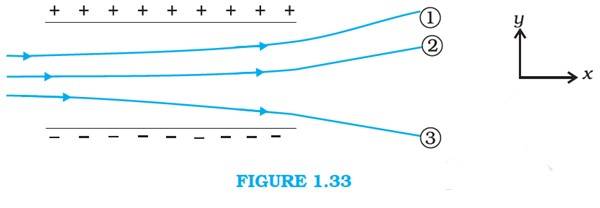Physics Ncert Solutions Class 12th
Get insights from 1.2k questions on Physics Ncert Solutions Class 12th, answered by students, alumni, and experts. You may also ask and answer any question you like about Physics Ncert Solutions Class 12th
Follow Ask QuestionQuestions
Discussions
Active Users
Followers
New answer posted
5 months agoContributor-Level 10
1.15 (a) Electric field intensity, E = 3 î N/C
Magnitude of electric field intensity, =
N/C
Side of the square, s = 10 cm = 0.1 m
Area of the square, A = = 0.01
The plane of the square is parallel to the y-z plane, hence the angle between the unit vector normal to the plane and electric field, = 0
Flux ( through the plane is given by the relation, = =
C
(b) When the normal to its plane make a 60 angle with x-axis, = 60
. From the equation =we get =
C
New answer posted
5 months agoContributor-Level 10
10.4 Distance between the slits, d = 0.28 mm = 0.28 m
Distance between the slits and the screen, D = 1.4 m
Distance between the central bright fringe and the fourth ( n = 4) fringe, u = 1.2 cm = 1.2 m
In case of a constructive interference, we have the relation for the distance between two fringes as : u = n where n = order of fringes = 4 and = wavelength of the light used
Hence, = = = 6 m = 600 m = 600 nm
Hence, wavelength of the light is 600 nm.
New answer posted
5 months agoContributor-Level 10
10.3 The refractive index of glass, = 1.5
Speed of light in vacuum, c = 3.0 m/s
Speed of light in glass is given by the relation, = = = 2 m/s
The speed of light in glass is not independent of the colours of light. The refractive index of a violet component of white light is less than the speed of red light in glass. Hence, violet light travels slower than red light in a glass prism.
New answer posted
5 months agoContributor-Level 10
1.14 Since the charges 1 & 2 are attracted towards + ve, their charges will be – ve. The charge 3 is attracted towards – ve, hence its charge will be +ve.
The charge to mass ratio (emf) is directly proportional to the displacement, charge 3 will have the highest charge to mass ratio.
New answer posted
5 months agoContributor-Level 10
Ans.10.2 The shape of the wave front in case of a light diverging from a point source is spherical.
The shape of the wave front in case of a light emerging out of a convex lens when a point source is placed at its focus is a parallel grid.
The portion of the wave front of light from a distant star intercepted by the Earth is a plane.
New answer posted
5 months agoContributor-Level 10
10.1 Wavelength of incident monochromatic light, = 589 nm = 589 m
Speed of light in air, c = 3 m/s
Refractive index of water, = 1.33
In case of reflection, the ray goes back to the same medium. Hence wavelength, frequency and speed of reflected beam will be same as incident beam.
Frequency of light beam is given by the relation, = = = 5.09 Hz.
Hence speed = 3 m/s, Wavelength = 589 m, Frequency = 5.09 Hz of incident ray and reflected ray will remain unchanged.
(i) Frequency = does not depend on the property of the medium in
New answer posted
5 months agoContributor-Level 10
1.13 When the third uncharged sphere C is brought in contact with the sphere A, then the charge is shared and becomes half. Then
= and = =
When the charged sphere C is brought in contact with charged sphere B, the charge between both the sphere is shared and becomes half
(q + =
Hence the force of repulsion between sphere A and B can be given as
F =
, where = Permittivity of free space = 8.854 = = = =
=
= 5.695N
New answer posted
5 months agoContributor-Level 10
1.12 (a) Charge on sphere A, = 6.5 C
Charge on sphere B, = 6.5 C
Distance between the spheres, r = 50 cm = 0.5 m
Force of repulsion between two spheres
F =
, where = Permittivity of free space = 8.854
Therefore, F =
N = 0.0152 N = 1.52 N
(b) Charge on sphere A, = 2 6.5 C = 1.3
Charge on sphere B,
Distance between the spheres, r =
Force of repulsion between two spheres
F =
New answer posted
5 months agoContributor-Level 10
13.31 Amount of Electric power to be generated, P = 200000 MW
10% of which to be obtained from nuclear power.
Hence, amount of nuclear power = 10% of 2
= 2
Heat energy release per fission of a
Efficiency of a reactor = 25%
So the amount of electrical energy converted from heat energy per fission = 25% of 200 MeV = 50 MeV
= 50
Therefore, number of atoms required per year =
1 mole of
Hence the mass of 7.884
Hence, the Urani
New answer posted
5 months agoContributor-Level 10
13.30 Amount of hydrogen, m = 1 kg = 1000 g
1 mole of hydrogen, i.e. 1 g of hydrogen (
1 kg of hydrogen contains = 1000
Within Sun, four (
Hence the energy released from fusion of 1 kg of
Amount of
1 mole of
1 kg of
It is known that the amount of energy released in the fission of 1 atom of
Taking an Exam? Selecting a College?
Get authentic answers from experts, students and alumni that you won't find anywhere else
Sign Up on ShikshaOn Shiksha, get access to
- 65k Colleges
- 1.2k Exams
- 682k Reviews
- 1800k Answers

